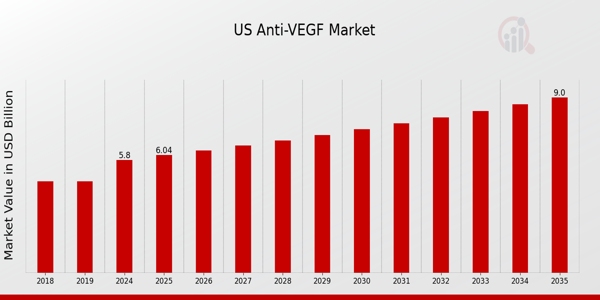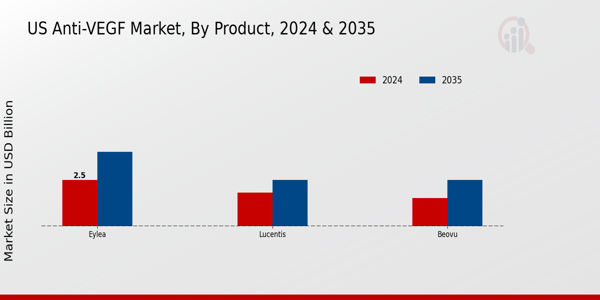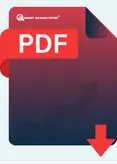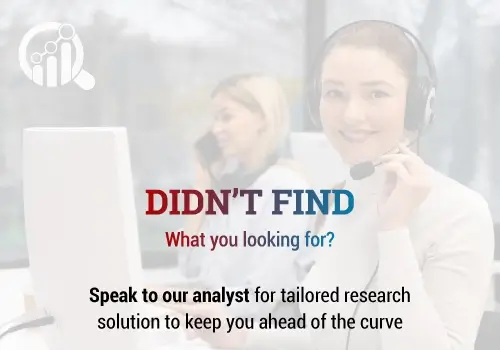US Anti-VEGF Market Overview:
As per MRFR analysis, the US Anti-VEGF Market Size was estimated at 5.23 (USD Billion) in 2023.
The US Anti-VEGF Market Industry is expected to grow from 5.8(USD Billion) in 2024 to 9 (USD Billion) by 2035. The US Anti-VEGF Market CAGR (growth rate) is expected to be around 4.075% during the forecast period (2025 - 2035).
Key US Anti-VEGF Market Trends Highlighted
The US Anti-VEGF Market is primarily driven by the increasing prevalence of retinal diseases, including diabetic retinopathy and age-related macular degeneration (AMD). As older individuals are more susceptible to these conditions, the ageing population makes a substantial contribution to this increase. In addition to the demographic transition, improvements in drug formulations and delivery methods are propelling patient outcomes and enhancing the efficacy of treatment. New therapies that target these pathways are being developed because of the increasing comprehension of vascular endothelial growth factor (VEGF) signaling, which is expanding the treatment options available to healthcare providers.
The potential to combine Anti-VEGF therapy with other treatment modalities, such as corticosteroids or laser therapy, is a prominent opportunity to be explored in the US market. This method may result in enhanced patient outcomes and may be of interest to healthcare systems that are developing cost-effective solutions. In addition, there is a growing emphasis on personalized medicine, which has the potential to create novel patient management pathways by customizing anti-VEGF treatments to individual patient profiles. Trends in the US anti-VEGF market have recently indicated a transition towards a greater demand for biosimilars. With the expiration of patents for the most prominent anti-VEGF therapies, biosimilars are offering more affordable alternatives, which have the potential to decrease healthcare expenditures. New opportunities for improving treatment adherence and efficacy in the long term are emerging as technology is increasingly integrated into patient management.

Source: Primary Research, Secondary Research, Market Research Future Database, and Analyst Review
US Anti-VEGF Market Drivers
Increasing Prevalence of Age-Related Macular Degeneration (AMD)
The increasing prevalence of Age-Related Macular Degeneration (AMD) is a significant driver for the US anti-VEGF market Industry. According to the National Eye Institute, it is expected that by 2050, the number of Americans affected by AMD may reach 3.7 million, which highlights a growing number of potential patients for anti-VEGF therapies. As the population ages, particularly with the Baby Boomer generation retiring, the demand for effective treatments for AMD is expected to surge.
This demographic shift necessitates innovative anti-VEGF solutions, prompting investment from leading pharmaceutical companies like Regeneron Pharmaceuticals and Novartis, which have been pivotal in advancing treatment options through Research and Development initiatives. Their considerable market presence and continued focus on AMD-related therapies further solidify the forecasted growth within the US Anti-VEGF Market.
Advancements in Drug Formulations and Delivery Systems
Innovations in drug formulations and delivery systems for anti-VEGF treatments are driving growth in the US anti-VEGF market Industry. Recent developments, such as extended-release formulations and devices allowing for more convenient administration of treatments, enhance patient compliance and treatment efficacy. For instance, companies like Regeneron are exploring new delivery methods that reduce the frequency of injections. A study published in the Journal of Ocular Pharmacology and Therapeutics highlights that improved delivery systems can enhance patient adherence by as much as 30%, ultimately expanding the market by reaching previously underserved patient populations.
Rising Awareness and Early Detection of Ocular Diseases
Rising awareness and early detection of ocular diseases have significantly influenced the US anti-VEGF market Industry. Campaigns from the American Academy of Ophthalmology have been instrumental in promoting regular eye exams, increasing the number of diagnosed cases of diseases like diabetic retinopathy and AMD. This is crucial, as the Centers for Disease Control and Prevention indicate that diabetic eye disease affects 7.7 million Americans, signifying a growing market for treatment options.
Early detection coupled with the availability of anti-VEGF therapies provides a strong rationale for patients to seek out these treatments, ultimately fostering market growth.
Supportive Regulatory Frameworks for Anti-VEGF Therapies
Supportive regulatory frameworks play a vital role in driving the US anti-VEGF market Industry. The U.S. Food and Drug Administration's streamlined approval processes for new anti-VEGF therapies and indications encourage innovation and ensure rapid availability of effective treatments to patients. In recent years, the FDA has been proactive in expediting review timelines for drug applications, particularly for groundbreaking treatments for serious conditions such as AMD and diabetic retinopathy.
This supportive regulatory landscape not only fosters a competitive market but also incentivizes companies to invest further in Research and Development, thereby accelerating the introduction of advanced anti-VEGF options to meet the needs of a growing patient population.
US Anti-VEGF Market Segment Insights:
Anti-VEGF Market Product Insights
The US Anti-VEGF Market, characterized by its crucial role in addressing retinal diseases such as Age-related Macular Degeneration and Diabetic Retinopathy, showcases a robust product segmentation. Eylea, Lucentis, and Beovu represent significant components within this sector, each contributing uniquely to the treatment landscape. Eylea has gained notable traction owing to its extended dosing interval, thereby enhancing patient compliance and reducing the frequency of injections for those suffering from visual impairments resulting from retinal vascular diseases.
Lucentis, as one of the pioneering anti-VEGF therapies, holds a formidable presence in the market, credited with demonstrating substantial efficacy in numerous clinical studies over the years. Its established use in clinical practice supports a loyal adoption among healthcare providers. On the other hand, Beovu, while being relatively newer to the market, has captured attention due to its potential for extended intervals between doses, positioning it as a competitive option. This diversity among the products allows for tailored treatment plans, accommodating various patient needs and preferences, which is critical in the US healthcare landscape.
The US Anti-VEGF Market has seen a progressive shift towards these therapeutics, driven by factors such as rising incidences of retinal diseases, an aging population, and increased awareness among patients regarding treatment options. However, the market also faces challenges, including high treatment costs and the potential for adverse effects associated with long-term use. Nevertheless, opportunities abound in this market segment, particularly as ongoing Research and Development efforts yield innovations aimed at improving the efficacy and safety profiles of these therapies.
Overall, the product segmentation within the US Anti-VEGF Market remains vital in addressing the growing burden of vision loss and continues to evolve in response to patient and clinician demands.

Source: Primary Research, Secondary Research, Market Research Future Database, and Analyst Review
Anti-VEGF Market Disease Insights
The US Anti-VEGF Market focuses significantly on the Disease segment, addressing critical conditions such as Macular Edema, Diabetic Retinopathy, Retinal Vein Occlusion, and Age-Related Macular Degeneration. These conditions are prevalent in the aging population, which is expected to rise, thereby increasing the demand for anti-VEGF therapies in the US. Macular Edema leads to vision impairment and, if untreated, can result in irreversible damage, highlighting its importance in the market landscape. Diabetic Retinopathy, a leading cause of vision loss among people with diabetes, requires effective management through Anti-VEGF treatments, showcasing its significance in both public health and market growth.
Retinal Vein Occlusion is another condition that has garnered attention due to its high incidence rate among older adults. Meanwhile, Age-Related Macular Degeneration is a leading cause of blindness in older adults, emphasizing its dominating position within the market due to its vast patient population. The challenges in these segments, such as the need for ongoing research and development, coupled with opportunities arising from technological advancements in treatment, shape the trajectory for growth within the US Anti-VEGF Market. Strategies focused on patient accessibility and education will continue to drive demand for Anti-VEGF therapies addressing these prevalent diseases.
US Anti-VEGF Market Key Players and Competitive Insights:
The competitive landscape of the US Anti-VEGF Market is characterized by a dynamic interplay of key players, innovative product offerings, and evolving treatment paradigms that reflect changing patient needs. The market is driven by the increasing prevalence of ophthalmic diseases such as age-related macular degeneration and diabetic retinopathy, leading to a growing demand for anti-VEGF therapies. As multiple companies strive to capture market share, their strategies encompass research and development, strategic partnerships, and extensive clinical trials. Firms are also exploring biosimilars as a means to improve accessibility and affordability, thereby attracting a broader patient base. The competitive insights manifest in the continuous refinement of existing products and the introduction of novel therapies aimed at enhancing efficacy and reducing treatment burden for patients.
In the US Anti-VEGF Market, Roche stands out due to its strong portfolio and a reputation for scientific innovation. The company has established a prominent market presence with its flagship products that have set the benchmark for efficacy in treating various retinal diseases. Roche’s strength lies in its robust research and development capabilities, which pave the way for continuous product improvement and innovation. The firm has secured a significant market share through strategic alliances and partnerships with healthcare providers, enhancing its distribution network. Its commitment to addressing unmet clinical needs has bolstered its reputation among patients and healthcare professionals alike, allowing Roche to maintain its competitive edge in a rapidly evolving landscape.
Amgen also plays a vital role in the US Anti-VEGF Market, offering a range of effective treatment options that address various ophthalmic conditions. The company's key products have been well-received, and its established presence in both the pharmaceutical and biotechnology sectors enhances its credibility. Amgen's strengths lie in its advanced research initiatives and dedication to developing cutting-edge therapies designed to improve patient outcomes. Recent mergers and acquisitions have further solidified Amgen's position in the market, enabling it to expand its capabilities and product offerings. The strategic alignment with other firms has allowed Amgen to leverage synergies that boost operational efficiency and foster innovation. In navigating the complexities of the market, Amgen continues to target specific patient segments, ensuring that its anti-VEGF therapies meet the evolving needs of US healthcare providers and patients alike.
Key Companies in the US Anti-VEGF Market Include:
- Regeneron Pharmaceuticals
US Anti-VEGF Market Industry Developments
In recent months, the US Anti-VEGF Market has witnessed notable developments, particularly as companies like Regeneron Pharmaceuticals and Bayer continue to expand their product offerings and enhance their market presence. Regeneron’s Eylea remains a leading treatment for retinal diseases, and the company is actively pursuing label expansions to bolster its usage. Moreover, in September 2023, Horizon Therapeutics announced a strategic collaboration with AbbVie to develop new treatments in the space, aiming to leverage AbbVie's strong portfolio in eye care. Notably, Amgen's acquisition of WeWork's subsidiary in August 2023 indicates a focus on integrating new technologies for patient engagement and treatment adherence. Growth in the US Anti-VEGF Market is driven by rising incidences of age-related macular degeneration and diabetic retinopathy, prompting increased investments in Research and Development from key players, including Novartis and Bristol Myers Squibb. With market dynamics shifting, regulatory approvals for innovative therapies are expected to influence the competitive landscape in the future. Over the past two years, significant advancements have included the FDA approval of new anti-VEGF agents, enhancing treatment options for patients across the US.
Anti-Vegf Market Segmentation Insights
-
Anti-VEGF Market Product Outlook
- Eylea
-
Anti-VEGF Market Disease Outlook
- Macular Edema
- Age-Related Macular Degeneration
|
Report Attribute/Metric
|
Details
|
|
Market Size 2023
|
5.23(USD Billion)
|
|
Market Size 2024
|
5.8(USD Billion)
|
|
Market Size 2035
|
9.0(USD Billion)
|
|
Compound Annual Growth Rate (CAGR)
|
4.075% (2025 - 2035)
|
|
Report Coverage
|
Revenue Forecast, Competitive Landscape, Growth Factors, and Trends
|
|
Base Year
|
2024
|
|
Market Forecast Period
|
2025 - 2035
|
|
Historical Data
|
2019 - 2024
|
|
Market Forecast Units
|
USD Billion
|
|
Key Companies Profiled
|
Roche, Amgen, Bayer, Bristol-Myers Squibb, EyePoint Pharmaceuticals, Santen Inc., Santen Pharmaceutical, Alimera Sciences, Horizon Therapeutics, Regeneron Pharmaceuticals, AbbVie, Novartis, Ocular Therapeutix, Pfizer, Aerie Pharmaceuticals
|
|
Segments Covered
|
Product, Disease
|
|
Key Market Opportunities
|
Increasing prevalence of retinal diseases, Growing elderly population demands, Advances in drug delivery systems, Rising awareness of eye health, Expanding telehealth for ophthalmology consultations
|
|
Key Market Dynamics
|
Increased patient population, High treatment costs, Emerging biosimilars competition, Advancements in drug formulations, Expanding clinical applications
|
|
Countries Covered
|
US
|
Frequently Asked Questions (FAQ):
The US Anti-VEGF Market is expected to be valued at 5.8 billion USD in 2024.
By 2035, the US Anti-VEGF Market is anticipated to reach a value of 9.0 billion USD.
The CAGR for the US Anti-VEGF Market is expected to be 4.075 percent from 2025 to 2035.
Eylea is projected to hold the largest market share with a valuation of 2.5 billion USD in 2024.
Lucentis is expected to reach a market size of 1.8 billion USD in 2024.
Beovu is anticipated to contribute a market size of 2.5 billion USD by 2035.
Major players include Roche, Amgen, Bayer, and Regeneron Pharmaceuticals, among others.
Potential challenges could include regulatory hurdles and increased competition from emerging therapies.
Growth opportunities may arise from advancements in treatment methods and the increasing prevalence of eye diseases.
The market is anticipated to show steady growth across various regions within the United States.





















